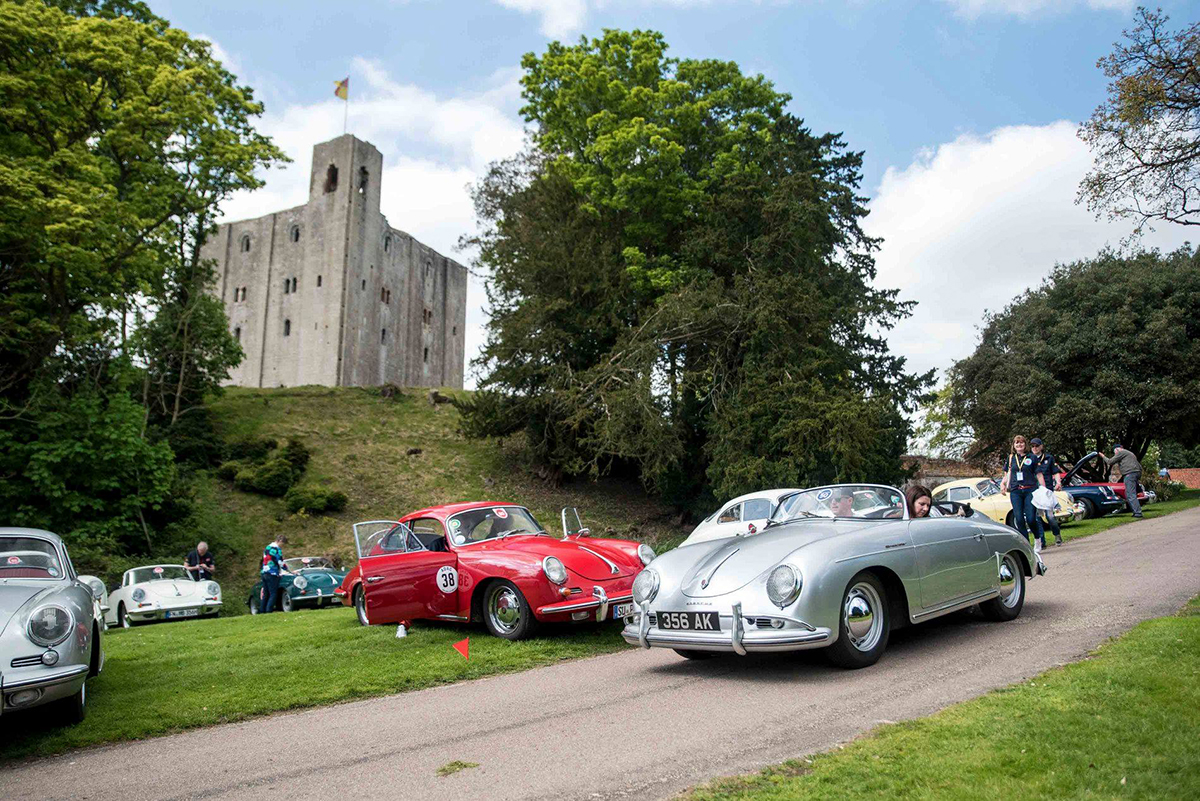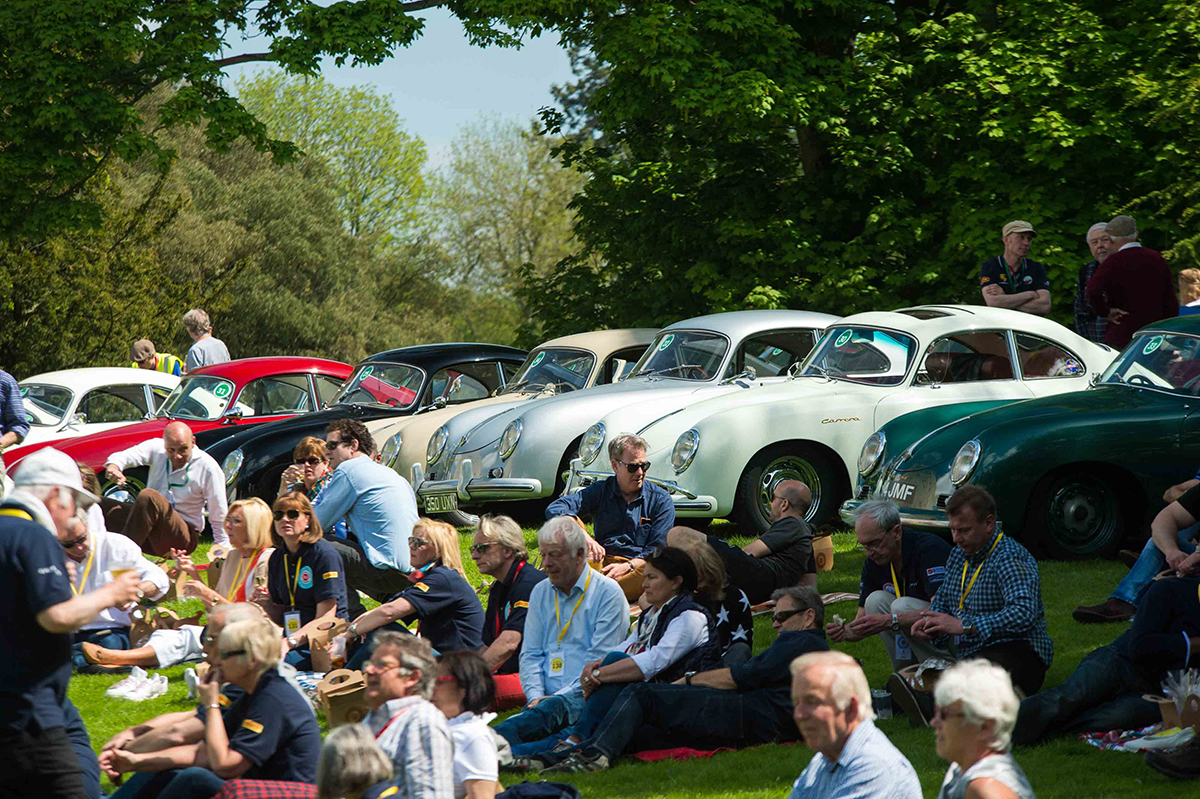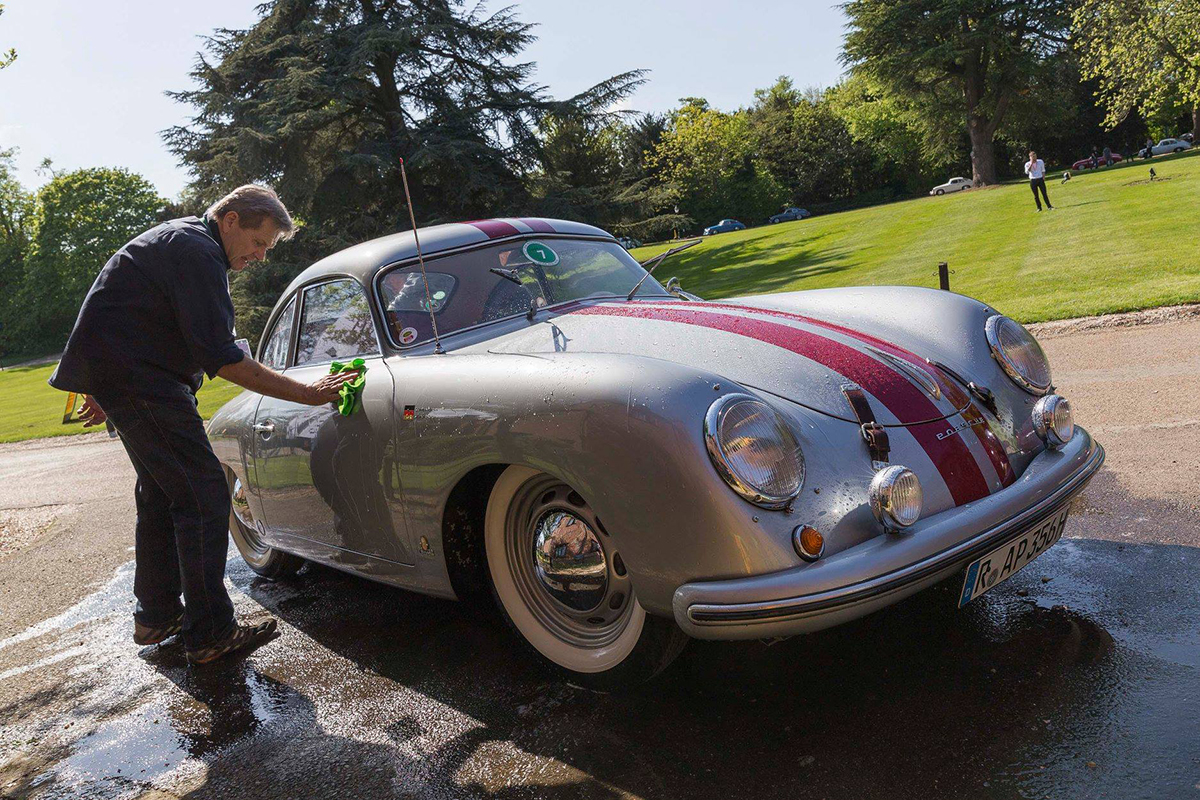Celebrating the longevity of Porsche’s original sports car on the 43rd 356 International
On the clockwise M25 around Watford, an early start into bank holiday traffic takes a decisive turn for the better. Shimmering in the sunshine of a perfect May morning, a pristine silver 356 hoves into view, its diminutive coupé outline and tiny rear tyres at comical odds with the gigantic compact SUVs and five-door hatchbacks surrounding it.
Tucking in behind the Porsche, with windows down you can hear the determined burble of its unstressed flat-four, watch the improbable composure of a seventy-year old design over the undulations and expansion gaps of London’s rickety orbital, even catch the occasional, delightful whiff of old-school exhaust.
As the traffic thins and our speed builds, the 356 keeps pace, and peeling off onto the empty M11 it even pulls away, the rhythmic burble momentarily more of a bark.
A few minutes later, weaving through the sleepy village of Finchingfield, another 356 appears, parked tightly along the village green amid a long line of modern cars. An earlier model this one, deep grey and casually canted over up the grassy bank.

Following signs to Castle Hedingham, the narrow hedge-lined lanes ahead are a quintessential slice of bygone British motoring. Dappled in sunlight, absent of markings, flanked by acres of arable land and perfectly quiet. Rounding a tight lefthand bend, we come upon a German-registered Speedster, roof down, side screens stowed, its passenger clutching the chopped windscreen in one hand and her sunhat in the other. The driver spies us in the rearview mirror and gently applies the throttle. Within seconds our speed has built to what feels like the sensible limit for the surroundings, but the little Speedster is so settled through the bends and fleet on the straights that it begins to pull away.
Hedingham Castle arrives sooner than expected, the lawns fringing its long drive already lined with 356s of every age and description. Today is a huge day not just for the Club, but also for some of the most preeminent global owners of Porsche’s original sports car. This is the 43rd 356 International, an event with deep roots in Porsche’s fanatical worldwide Club community. And an event that the Porsche Club GB has the honour of hosting in this all-important 70th year.
Some eighteen months in the making, the 43rd 356 International has been the cause of many very long days and more than a few sleepless nights for the Club’s team and the 356 Register. An incredible 136 cars are attending, carefully selected to attain a best possible blend of interest and rarity. Outside the main house, an original Gmund Coupé sits alone, basking in the sunshine. Up to the 900-year-old Norman keep, and cars of every sort have come from all four corners, parked in rows beneath the ruined walls, assorted number plates revealing epic journeys from as far afield as Florida and Russia.
Wandering among the cars, three rows deep in places and casually abandoned with maps, blankets, books and hats strewn around their small and simple cabins, you soon get a sense of the 356 as more than just a car. These beautiful yet practical, cherished yet hard-driven objects are touchpoints to a forgotten era of motoring and engineering as a whole. There is a subtlety and understated elegance to each and every one that belies the image of sports cars in the modern sense, even of Porsche as we usually think of it. Not an ounce of show on show, but instead the form following function of exacting, uncompromising post-war design. And an integrity of manufacture that is a distant memory for great swathes of the industry today.

The guests on the 356 International exude an easy nature complimentary to their cars. Mostly couples, mostly of middle-age, easy-going and unaffected, they are all hugely enthusiastic and approachable. They are quietly very knowledgeable, open and accommodating to our questions, and united by this shared passion and a determination to have fun.
Wandering among the rows of largely pristine Coupés and Cabriolets, Roadsters and Speedsters, we meet two couples who have driven in convoy from Zurich, a little under 1,000km according to one odometer, and are now basking together in Hedingham’s welcoming midday sun. Brun Lang is a member of the Porsche 356 Club in Switzerland, and his Speedster is the perfect example of a proper driver. In his possession since 1995, it has had a lick of paint but is otherwise unrestored and reveals a delightful patina to the leather and metal work in the unfussy cabin. This is the third 356 International for Brun and his wife, who have driven the car all over Europe without trouble. “Ultimately,” he observes with a shrug, “they just keep going.”
Parked beside them is Michael Porschet (quite aptly named as he observes), whose 1960 356 B T5 Cabriolet has undertaken similar pan-European driving duties, its 75bhp 1600cc more than enough for lengthy tours through Spain and Italy. Although these cars are not daily drivers as such, the season is an impressively long one, with meets scheduled throughout a busy-sounding summer until the far end of October.
Any sense that the 356 International is a male affair, with long-suffering wives riding shotgun, is easy to dismiss. Across the lawn we meet Gail Lumsden, lowering herself into the driver’s seat of her 1953 Pre-A coupé. She has owned Elsie for six years and drives her regularly, alongside her 1957 A Speedster. Stella, in case you were wondering. Despite living in London, Gail keeps her cars at Silverstone and softens the commute with her 997 Cabriolet.
What is it that makes the 356 so special? There isn’t a definitive answer among the crowds here, perhaps because there are too many equally good arguments to make. In an age of increasingly incredible headline speeds, the 356 is a car you can enjoy deeply at 60mph on a very average bit of British B-road. It’s also a car, someone explains, that you can sit comfortably in all day, doing 80mph on the motorway if needs must. Lots of words come up time and again; simple, practical, capable, fun.

The 356 was a car ahead of its time, something illustrated first by its longevity in series production from 1948 to 1965, and secondly by its rude health in the here and now. Its power was rarely excessive and even the smallest engines enjoyed a happy union with their contemporary chassis and brakes. These are cars, it seems, that reward you as you push, without demanding you wring them dry.
An experienced Porsche dealer among the guests observes a recent trend among serious collectors who are selling more modern fair to acquire 356s. After years playing second fiddle to the 911, it seems more and more people are realising that the intrinsic value of a 356 lies not just in its increasing age and scarcity, but in the fact that they are truly great cars to drive.
Gail voices a widely shared concern that the sudden spike in prices across the 356 market will hobble the prospects of ownership for the next generation of enthusiasts. This is perhaps the paradox for all classic Porsches. That a company that historically pursued a reasonably democratic ideal would wind up making cars so desirable in years to come that only the elite could afford them. The end game of which, of course, is that they become too valuable to use or even change hands regularly.
The size of the 43rd 356 International at least serves to underline just how strong and active support for the model currently is. Running from Thursday to Sunday, this highly organised tour of some of the Southeast’s most spectacular tourist spots, interwoven with many of its finest driving roads, will have taken in Hanbury Manor, a tour of the famous and secretive workshops of Maxted-Page, jousting at Hedingham Castle, dinner at Hatfield House, driving experiences at Wethersfield Airfield and a gala awards dinner at Duxford’s Imperial War Museum, attended by hundreds of owners and enthusiasts from all over the world. If their infectious enthusiasm doesn’t get passed on to a new generation, nothing will.

Porsche Post’s time on the tour is short lived, but the spirit of the event is intoxicating in just a few short hours. And our departure provides a perfect window onto what makes the 356 International tick. Walking out of the castle grounds we bump into none other than Tony Hatter, owner of a fabulous 356 A that he has subtly modded with Speedster seats, a twin-plug 912 engine and lowered suspension. Tony, a leading light at Porsche AG for over thirty years now, drove in tandem from Stuttgart with fellow designer Grant Larson and his late model SC. These two lynchpins of Porsche’s past and present are just strolling around the grounds like everyone else, soaking up the atmosphere.
We part company in front of a white 1960 B T5, owned by Fred Ferrier. In his possession since 1988 and the subject of much patient restoration over the years, Fred’s car is nevertheless a workhorse, evidenced by a cabin full of the detritus of daily life. Fred has driven his car to Denmark, Estoril, even around the Nurburgring. But what’s more impressive still is that he uses it as a daily. He demonstrates how he employs the elasticated door-pocket in lieu of a cupholder on his regular route back from the supermarket with a hot cup of coffee. “It’s a crap car for shopping,” he remarks, “as the food rolls all over the parcel shelf. But it’s another good excuse to drive it.”
No excuses needed. Least of all today.